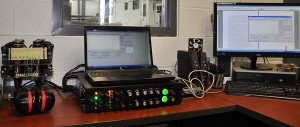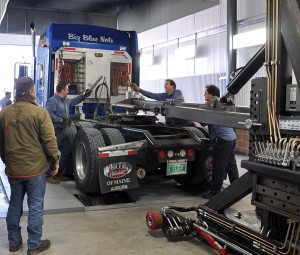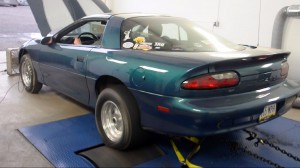 We here at Pittsburgh Power are always trying to come up with creative solutions to the challenges we (and you) face on a daily basis. Recently, one of our customers came up with a unique way to solve a situation we were having with our new dyno. Those of you who have not watched a chassis dyno operator prepare a semi-truck for testing might not realize that a large chain around the rear differential and 2-inch wide front tire straps with ratchet binders are all that hold the truck in place during a test. This binding method of securing a truck while on the dyno, which is the standard in the industry, has some associated problems we set out to correct.
We here at Pittsburgh Power are always trying to come up with creative solutions to the challenges we (and you) face on a daily basis. Recently, one of our customers came up with a unique way to solve a situation we were having with our new dyno. Those of you who have not watched a chassis dyno operator prepare a semi-truck for testing might not realize that a large chain around the rear differential and 2-inch wide front tire straps with ratchet binders are all that hold the truck in place during a test. This binding method of securing a truck while on the dyno, which is the standard in the industry, has some associated problems we set out to correct.
The first problem is that there is no weight on the fifth wheel. If the truck produces high horsepower or has bald tires, there will most likely be slippage on the dyno rollers, making accurate readings almost impossible. Also, binding the truck with chains is time-consuming, and the differential chain can (and will) chip the paint on the differential. If the truck has a custom rear bumper that is close to the ground, it may even be impossible to put the truck on the dyno at all.
A good friend of mine, Al Hemerson, a farmer, owner operator, and great thinker from Iowa, came up with our solution – why not have a floor-mounted hydraulic apparatus that connects to the fifth wheel through an extendable boom? He made several drawings for us, and then I took them to another friend of mine, Jon Anderson, who is a welder and fabricator, and told him what I wanted. Jon is another great thinker. Whatever you think you want to build, just give him the plans and come back several days later. After he thinks about it and makes his modifications, it may be entirely different from your original plans, but you will NOT be disappointed with the results! After a few months of fabricating, machining and welding, we now have the world’s ONLY chassis binding system of its kind – the Anderson-Hemerson Hitch, or as some around the shop call it, “The Giraffe”.
 This new chassis dyno binding system hooks into the fifth wheel and can pull the truck up onto the dyno’s rollers to the exact spot where you want it. “The Giraffe” can even pick the back of the truck up off the ground, move it to the right or left, and put as much as 100,000 pounds of pressure down on the drive tires. We have found that 3,000 to 4,500 pounds of downward pressure does a great job simulating a trailer and stabilizing the truck for a perfect dyno run. The downward pressure on the fifth wheel simulates a loaded trailer for performance results that are closer to real-world situations. Parasitic losses in drive tire alignment, tire tread pattern, and wheel bearing losses are more accurately observed with pressure on the fifth wheel. Even at 800 plus horsepower to the ground, there is no jumping, no lifting of the rear suspension, and no tire slippage. If it wasn’t for the noise of the engine and tires spinning, you wouldn’t even notice the truck was doing a dyno run. It takes less than a minute to hitch the truck and get it into position for the test. The Anderson-Hemerson Hitch is the first of its kind in the world, and the fastest and most secure way to dyno a semi-truck.
This new chassis dyno binding system hooks into the fifth wheel and can pull the truck up onto the dyno’s rollers to the exact spot where you want it. “The Giraffe” can even pick the back of the truck up off the ground, move it to the right or left, and put as much as 100,000 pounds of pressure down on the drive tires. We have found that 3,000 to 4,500 pounds of downward pressure does a great job simulating a trailer and stabilizing the truck for a perfect dyno run. The downward pressure on the fifth wheel simulates a loaded trailer for performance results that are closer to real-world situations. Parasitic losses in drive tire alignment, tire tread pattern, and wheel bearing losses are more accurately observed with pressure on the fifth wheel. Even at 800 plus horsepower to the ground, there is no jumping, no lifting of the rear suspension, and no tire slippage. If it wasn’t for the noise of the engine and tires spinning, you wouldn’t even notice the truck was doing a dyno run. It takes less than a minute to hitch the truck and get it into position for the test. The Anderson-Hemerson Hitch is the first of its kind in the world, and the fastest and most secure way to dyno a semi-truck.
Dave Norris, a partner of John Anderson, brought his wife Mary Lou and her 1995 Camaro to our shop to run on the pickup/race car chassis dyno. This dyno will hold 2,500 horsepower. This Camaro has a bored and stroked 350 Chevy which now has 396 cubic inches and a belt-driven supercharger producing 17 pounds of boost. At 15 psi of boost, the Chevy was producing 864 horsepower. It was a sight to behold when Dave put the throttle to the floor and this Camaro would try to leap off the dyno! We even had to chain the front of the car down to keep the tires on the concrete. This Camaro is drag-raced by Dave’s wife – and its street legal! So, whether you want to dyno your semi-truck, pickup truck, race car or street rod, we can do it.
For 35 years, we have always strived to find better ways to make the diesel engine burn cleaner, produce more fuel mileage, and live longer. There is a growing need in the industry to diagnose electrical and ECM hardware problems. We get many phone calls from owner operators telling us they have a bad ECM and need a replacement. We always ask why, because we hear a lot of stories about good ECMs getting replaced when an electrical problem involving a sensor or electrical harness was the true cause of the problem. Once an ECM is installed, very few shops will remove it for diagnosis off the truck. When a technician has gone through all the diagnostic tests he knows and still doesn’t find a problem, the ECM is usually blamed. If he’s wrong, you get stuck with a $3,000 bill and still have the same problem. We listened to the needs of the industry, and our engineering team has found yet another creative solution.
 The engineers at the Pittsburgh Power engineering center are busy developing systems to check the electronics of the semi-truck. Our engineering team has created a desktop engine simulator (DES) for the DDEC4. The DES allows us to run performance tests on the DDEC4 ECM by simulating the ECM running on the truck. A live set of injectors allows you to hear the injectors firing, even over the phone! It’s amazing to listen to the ECM run the injectors at various engine speeds. Sometimes, there will be a miss from one injector every third or fourth firing, which you can even hear over the phone. All engine operating conditions can be simulated, including high altitude, cold start-ups, and high coolant temperatures. The engine operating condition where the problem is worst can be replicated to see if the ECM responds correctly or is at fault. This allows us to assess the condition of the ECM and verify that it is (or is not) the problem. This is the world’s first invention of its kind, and only the beginning, as our three engineers are currently developing desktop engine simulators for Caterpillar and Cummins systems, as well. Stay tuned!
The engineers at the Pittsburgh Power engineering center are busy developing systems to check the electronics of the semi-truck. Our engineering team has created a desktop engine simulator (DES) for the DDEC4. The DES allows us to run performance tests on the DDEC4 ECM by simulating the ECM running on the truck. A live set of injectors allows you to hear the injectors firing, even over the phone! It’s amazing to listen to the ECM run the injectors at various engine speeds. Sometimes, there will be a miss from one injector every third or fourth firing, which you can even hear over the phone. All engine operating conditions can be simulated, including high altitude, cold start-ups, and high coolant temperatures. The engine operating condition where the problem is worst can be replicated to see if the ECM responds correctly or is at fault. This allows us to assess the condition of the ECM and verify that it is (or is not) the problem. This is the world’s first invention of its kind, and only the beginning, as our three engineers are currently developing desktop engine simulators for Caterpillar and Cummins systems, as well. Stay tuned!
Always thoroughly diagnose a problem before you start throwing parts at it. And remember, it is much easier for us to help you when you bring your truck to our shop, as opposed to answering questions over the phone. If you have any comments or questions, feel free to contact me at Pittsburgh Power in Saxonburg, PA by calling (724) 360-4080 or via e-mail at bruce@pittsburghpower.com today.
